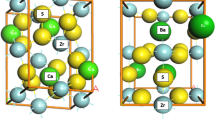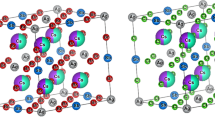Abstract
A new theoretical approach for describing the formation of multi-component solid solutions as a mixture of their binary components is proposed. The excess Gibbs energy of formation of such solid solutions is calculated for Cd1−xZnxTe1−ySey compounds with an arbitrary concentration of the elements. There is a new thermodynamic effect of a decrease in the excess Gibbs energy in solid solutions that contain mixed binary components formed during simultaneous doping of the cationic and anionic subsystems. The excess Gibbs energy of formation of the quaternary CdZnTeSe solid solution (at additional doping with selenium) in comparison to the ternary CdZnTe compounds can reach a value of some hundreds of J/mol, which considerably exceeds the standard entropy of formation of pure binary components for the given solution. Such an effect is connected with the emergence of strong covalent bonds in the mixture of binary components of the quaternary solid solution. This may explain the hardening effect, i.e., a considerable decrease in the number of extended defects observed during the growth of CdZnTeSe crystals. The proposed theory makes it possible to quantitively predict changes in the expected defect quality of the crystals with variations in the composition of the solid solutions.


Similar content being viewed by others
Data availability
All data generated and analysed during this study are included in this published article.
References
P. Fougeres, P. Siffert, M. Hageali, J.M. Koebel, R. Regal, CdTe and Cd1-xZnxTe for nuclear detectors: facts and fictions. Nucl. Instrum. Methods Phys. Res. Sect. A 428, 38–44 (1999). https://doi.org/10.1016/S0168-9002(98)01578-2
L. Verger, M. Boitel, M.C. Gentet, R. Hamelin, C. Mestais, F. Mongellaz, J. Rustique, G. Sanchez, Characterization of CdTe and CdZnTe detectors for gamma-ray imaging applications. Nucl. Instrum. Methods Phys. Res. Sect. A 458, 297–309 (2001). https://doi.org/10.1016/S0168-9002(00)00874-3
U.N. Roy, G.S. Okobiah Camarda, Y. Cui et al., Growth and characterization of detector grade CdMnTe by the vertical Bridgman technique. AIP Adv. 8, 105012 (2018). https://doi.org/10.1063/1.5040362
D. Alam, S.S. Nasim, S. Hasam, Recent progress in CdZnTe based room temperature detectors for nuclear radiation monitoring. Prog. Nuclear Energy 140, 103918 (2021). https://doi.org/10.1016/j.pnucene.2021.103918
A. Mycielski, A. Wardak, D. Kochanowska, M. Witkowska-Baran, M. Szot, R. Jakieła et al., CdTe-based crystals with Mg, Se, or Mn as materials for X- and gamma-ray detectors: Selected physical properties. Prog. Crys. Growth. Charact. Mater. 67, 100543 (2021). https://doi.org/10.1016/j.pcrysgrow.2021.100543
A. Rogalski, HgCdTe infrared detector material: history, status and outlook. Rep. Prog. Phys. 68, 2267–2336 (2005). https://doi.org/10.1088/0034-4885/68/10/R01
E. Damulira, Radiation dosimetry in medicine using II–VI semiconductors. J. Radiat. Res. Appl. Sci. 15, 72–82 (2022). https://doi.org/10.1016/j.jrras.2022.06.001
A. Hossain, A.E. Bolotnikov, G.S. Camarda, Y. Cui, G. Yang, K.H. Kim, R. Gul, L. Xu, R.B. James, Extended defects in CdZnTe crystals: effects on device performance. J. Cryst. Growth 312, 1795–1799 (2010). https://doi.org/10.1016/j.jcrysgro.2010.03.005
D.J. Larson Jr., R.P. Silberstein, D. Di Marzo, F.C. Carlson, D. Gillies, G. Long, M. Dudley, J. Wu, Compositional, strain contour and property mapping of CdZnTe boules and wafers. Semicond. Sci. Technol. 8(6S), 911–915 (1993)
U.N. Roy, G.S. Camarda, Y. Cui, R. Gul, A. Hossain, G. Yang, J. Zazvorka, V. Dedic, J. Franc, R.B. James, Role of selenium addition to CdZnTe matrix for room-temperature radiation detector applications. Sci. Rep. 9, 1620 (2019). https://doi.org/10.1038/s41598-018-38188-w
U.N. Roy, G.S. Camarda, Y. Cui, R. Gul, G. Yang, J. Zazvorka, V. Dedic, J. Franc, R.B. James, Evaluation of CdZnTeSe as a high-quality gamma-ray spectroscopic material with better compositional homogeneity and reduced defects. Sci. Rep. 9, 7303 (2019). https://doi.org/10.1038/s41598-019-43778-3
U.N. Roy, G.S. Camarda, Y. Cui, R.B. James, High-resolution virtual Frisch grid gamma-ray detectors based on as-grown CdZnTeSe with reduced defects. Appl. Phys. Lett. 114, 232107 (2019). https://doi.org/10.1063/1.5109119
S.U. Egarievwe, U.N. Roy, E.O. Agbalagba, B.A. Harrison, C.A. Goree, E.K. Savage, R.B. James, Optimizing CdZnTeSe frisch-grid nuclear detector for gamma-ray spectroscopy. IEEE Access 8, 137530–137539 (2020). https://doi.org/10.1109/ACCESS.2020.3012040
S.K. Chaudhuri, J.W. Kleppinger, O. Karadavut, R. Nag, K.C. Mandal, quaternary semiconductor Cd1−xZnxTe1−ySey for high-resolution, room-temperature gamma-ray detection, Crystals 11, #827 (2021). https://doi.org/10.3390/cryst11070827
A. Yakimov, D.J. Smith, J. Choi, S.L. Araujo, Growth and characterization of detector-grade CdZnTeSe by horizontal Bridgman technique. In: Proc. SPIE 11114, Hard X-ray, Gamma-Ray, and Neutron Detector Physics XXI, 111141N (2019). https://doi.org/10.1117/12.2528542
Arieh Ben-Naim (The Hebrew University, Jerusalem, Israel). Molecular theory of solutions. Oxford University Press Inc., Oxford, New York, 2006. https://doi.org/10.1021/ja0698174
T. Onda, R. Ito, Thermodynamic theory of III–V semiconductor quaternary solid solutions. Jpn. J. Appl. Phys. 26(8), 1241–1251 (1987). https://doi.org/10.1143/JJAP.26.1241
K.T. Jacob, K. Fitzner, The estimation of the thermodynamic properties of ternary alloys from binary data using the shortest distance composition path. Thermochim. Acta 18(2), 197–206 (1977). https://doi.org/10.1016/0040-6031(77)80019-1
N. Elayech, H. Fitouri, Y. Essouda, A. Rebey, B. El Jani, Thermodynamic study of the ternary system gallium-arsenic-bismuth. Phys. Status Solid. C 12(1–2), 138–141 (2014). https://doi.org/10.1002/pssc.201400147
G.R. Kirchoff, The laws of the mechanical heat theory and a use of these. Pogg. Ann. 103, 203 (1858)
P. Atkins, J. de Paula, J. Keeler, Atkins’ physical chemistry, 11th edn. (Oxford University Press, New York, 2018)
A. Münster, Classical Thermodynamics (Wiley Interscience, London, 1970). https://doi.org/10.1002/bbpc.19710750348
Thermal Constants of Substances: Vol. 1–8 (Ed. V.S. Yungman), Wiley, New York (1999).
CRC Handbook of Chemistry and Physics (95th ed.), CRC Press (2014)
R. Gul, U.N. Roy, G.S. Camarda, A. Hossain, G. Yang, P. Vanier, V. Lordi, J. Varley, R.B. James, A comparison of point defects in Cd1-xZnxTe1-ySey crystals grown by bridgman and travelling heater methods. J. Appl. Phys. 121(12), 125705 (2017). https://doi.org/10.1063/1.4979012
B. Park, Y. Kim, J. Seo, J. Byun, V. Dedic, J. Franc, A.E. Bolotnikov, R.B. James, K. Kim, Bandgap engineering of Cd1−xZnxTe1−ySey (0<x<0.27, 0<y<0.026). Nucl. Instrum. Methods Phys. Res. Sect. A 1036, 166836 (2022)
U.N. Roy, G.S. Camarda, Y. Cui, R.B. James, Optimization of selenium in CdZnTeSe quaternary compound for radiation detector applications. Appl. Phys. Lett. 118, 152101 (2021). https://doi.org/10.1063/5.0048875
Author information
Authors and Affiliations
Contributions
All authors contributed to the study and analysis. The original draft of the manuscript was written by Dr. Sergei Naydenov, and all the authors have read and approved the final manuscript.
Corresponding author
Ethics declarations
Conflict of interest
The authors declare that they have no known competing financial interests or personal relationships that could have appeared to influence the work reported in this paper.
Additional information
Publisher's Note
Springer Nature remains neutral with regard to jurisdictional claims in published maps and institutional affiliations.
Rights and permissions
Springer Nature or its licensor (e.g. a society or other partner) holds exclusive rights to this article under a publishing agreement with the author(s) or other rightsholder(s); author self-archiving of the accepted manuscript version of this article is solely governed by the terms of such publishing agreement and applicable law.
About this article
Cite this article
Naydenov, S.V., Pritula, I.M. Hardening of multi-component CdZnTeSe solid solutions: a theoretical approach. Appl. Phys. A 129, 812 (2023). https://doi.org/10.1007/s00339-023-07109-8
Received:
Accepted:
Published:
DOI: https://doi.org/10.1007/s00339-023-07109-8




